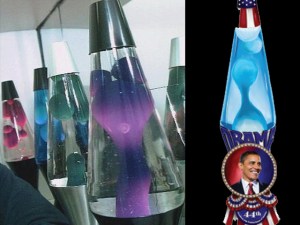
For this most recent report of Mary and Jesus appearing unexpectedly we head down under, to Sydney, Australia, where one John Smith – at least that’s what he’s calling himself – has made public his psychedelic discovery: “I turned on my brand new lava lamp and watched in awe as the unmistakable image of the Holy Mary cradling the Baby Jesus appeared.” According to this Herald Sun article, Smith has kept this visual manifestation private for over a year, during which he has kept the lamp unplugged and his life has gone from ho-hum to dandy – including lucrative job offers and a woman. Now it’s time to share this “miracle” with the world, hence www.holymarylamp.com.
The article, dated January 16, reports that at the time of writing the site’s visitor counter read 251, but as of writing this, also on January 16, the ticker reads over 54,000! Never ceases to amaze me how folks love looking at these images (or love to hate looking at them).
For those of you keeping score at home, this is the first time a lava lamp has been the vessel for such a vision, which is kind of surprising really. There have been plenty of foodstuffs, plastic bags, stones, driftwood and chipping paint but no lava lamps. These colorful novelty items have been around since the 1960s, becoming a critical accoutrement to any hippie hideaway. I bet John Smith isn’t the first person to turn on a lava lamp and see Jesus, but he’s certainly the first guy to dedicate a website to his vision.

Not that lava lamps are underrepresented in today’s culture, as this Obama lava lamp proves.



2 comments:
History of the Lava Lamp Singapore-born Englishman Edward Craven Walker invented the lava lamp in the 1960s. His U.S. Patent 3,570,156 for "Display Device" was filed in 1965 and issued in 1968. Walker's company was named Crestworth and was based in Poole, Dorset in the United Kingdom. Walker named the lamp Astro and had variations such as the Astro Mini, the Astro Coach lantern and presented it at a Brussels trade show in 1965, where the entrepreneur Adolph Wertheimer noticed it. Wertheimer and his business partner William Rubinstein bought the American rights and produced it as the Lava Lite via Lava Corporation or Lava Manufacturing Corporation, the origin of the word "lava" for this lamp. Wertheimer sold his shares to Hy Spector. Rubinstein and Spector went on to manufacture and market the Lava Lite in his Chicago factory at 1650 W. Irving Park Rd in the mid-60s. The lamps were a success throughout the 60s and early 70s. Lava Corporation's name changed to Lava-Simplex in the early 1970s.
Hazards of the Lava Lamp An episode of the American TV show MythBusters demonstrated that heating a lava lamp on a stove could make it explode, and that injuries from an explosion could be fatal. The inspiration for that experiment came from a story concerning a man who in 2004 died after a lamp he was heating on a stove to avoid waiting for the wax to warm up exploded, sending glass into his chest.
wow, I was visited by the Lava Madonna as well, over two years ago now; I thought i was the only one!
it made the news http://blogs.discovermagazine.com/badastronomy/files/2008/mary_lavalamp.jpg
Post a Comment